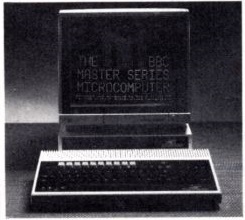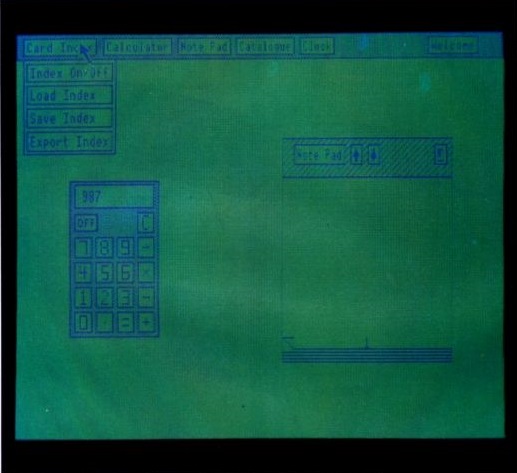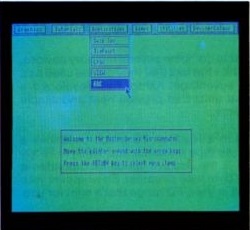
Acorn User
 1st November 1986
1st November 1986
Categories: Review: Machine
Author: David Atherton
Publisher: Acorn Computers
Machine: European Machines
Published in Acorn User #052
What do you get for your money with the new Master Compact? Here compared to its big brother, the Master 128.
All Creatures Great And Small
 |
The Master Compact is the latest micro to be launched by Acorn and builds on the Amstrad concept of 'one plug' supplying everything required, thus minimising the necessity for separate boxes and cables. Unlike any previous Acorn micro, the Compact is being sold with a bundled disc drive and monitor. As with Amstrad, you must buy computer and disc drive together. However, the choice of a colour or monochrome (green) monitor or a TV adaptor is available.
In essence, the computer is a Master 128 in a smaller box with printer, disc and joystick interfaces. All other interfaces are removed, as is some of the system software. The purpose, of course, is to produce a lower cost machine. See the panel for a detailed rundown of the differences.
The system is packaged in three boxes, one containing the monitor, another the disc drive and finally the keyboard/computer. It assembles as a light moveable keyboard in front of a monitor on a stand. The keyboard can be pulled a foot away from the monitor. The keyboard is almost identical to the Master 128, in a case styled on the Acorn Communicator, measuring 426 x 219 x 75mm, about halfway between the width of a model B and a Master, and about two-thirds the depth of a Model B.
The drive-come-stand is a neat flat box measuring 351 x 333 x 95mm. Computer and stand are in the standard BBC cream colour with dark panels and logos. The drive is a Sony 3.5" unit, and is double-sided, double-density 80-track. Like all 3.5" drives, it uses a button eject. The power supply for drive and computer is contained in this box. A mains feed for the monitor is supplied. All mains is fed on IEC320 plugs and sockets (like modern kettles and Epson printers) and for the first time on BBC computers, you can disconnect the mains wire at the computer end. This is helpful when moving the computer and other equipment.
The monitors are excellent. Both mono and colour are high-quality Philips models, the colour model is a 0.42mm dot pitch, the level generally billed as high resolution. 80 column text is perfectly legible on the colour monitor.
The mono monitor has even better resolution, easily exceeding the highest resolution (640 x 256) generated by the computer. A monitor lead is also supplied.
The kit is built to high standards and will provide several years' service, just as BBC micros have done.
There are eight sockets located on the back of the machine. From left to right they are composite video; RGB video; Econet; RS232; Joystick/Mouse; printer; disc drive; and power input.
The composite video and RGB sockets are for the mono and colour monitors respectively. If you intend using your own monitor with the Compact, the RGB connection is the same as other Acorn/BBC Micros. The mono connector is an Electron-style photo socket.
Standard Econet and RS232 sockets are optional upgrades, so as nothing is connected to them, they are covered up. The RS232 upgrade is just four plug-in chips, and the Econet module is the same as that supplied for the Master 128.
The ANFS version 4.23 or later is required for the Compact to function correctly on the network. All Acorn stocks are being updated, but if you are buying from a dealer check the version number of the ROM. The disc and printer connectors are the same as precious BBC Micros, but have been physically changed. The disc cable now connects to a 25-way D-type connector (like the RS232 socket on some micros) and the printer to a 24-way Delta. This is not of crucial importance for new users as the correct cable is supplied for the 3.5" drive and printer cables will be no more expensive than before. If however you are upgrading and you already own a drive and printer, then you'll have to spend about £20 on new cables, or make them up. All the pin labels are to be found in the back of the Welcome Guide.
The joystick input has completely changed. The old analogue-to-digital chip on previous machines has been replaced by an Atari, Commodore and Amstrad compatible switched joystick/mouse socket, and states people who already work with mice should plug them in there. A QuickShot II joystick was tested and functioned without any problems.
The Operating System will read switches or will emulate the analogue system. The latter allows compatibility with existing joystick options on programs. The sensitivity is altered by *FX 190. Response time was a little slow in some games. This is only a compatibility issue - games altered specifically for the Compact should have better response.
The keyboard has only slightly changed. The @ symbol shares a key with zero, and the position it vacates is now known as the code key. If this key is pressed in conjunction with CTRL and SHIFT, then the next key pressed has 128 added to its ASCII value. This has been provided for international versions of the machine, but is also a useful method of typing colour codes directly from the keyboard.
There is a 50-way expansion edge connector on the right of the machine. This has most of the user 6522, FRED and JIM selects (and address lines), and miscellaneous lines such as CRTC light pen and reset. Two ROM slots can, by moving a link, appear on the expansion bus, allowing hardware and software in one box. The bus is similar to the cartridge outlets on the Master 128. Acorn expects that third parties will produce additional boxes.
This machine sports four ROM sockets, as well as four banks of Sideways RAM. One socket will take 32K chips in the same way as the B+. The other slots are taken up by the Operating System, which duplicates itself in slots 9-12. The four ROM sockets and four banks of RAM are a good combination, plus there are no expensive cartridges to buy. The sockets are easily accessible on the right-hand side of the circuit board. It is possible to fit a 128K ROM in place of the 64K ROM supplied. This, Acorn says, is for international variants of the machine - not for a Master 128 megaROM!
The 210 page Welcome Manual is well written. Once again, Acorn has left the detailed information for its technical books, and has concentrated on novice users. The bundled software is well documented with 22 pages on View, 14 pages on ABC and 14 pages on the other programs. Logo has its own manual. A third of the book is devoted to BBC Basic and there is a detailed section on using ADFS, the standard filing system.
The Operating System supplied is essentially that of the Master, with code removed where hardware is missing. Acorn has also taken the opportunity to make improvements, for example the *SRLOAD command to install a ROM image into Sideways RAM, can now be suffixed with 'I' and the image will be initialised as a ROM, without the need to press BREAK. The only other fireware supplied is the Advanced Disc Filing System (ADFS) and the latest version of Basic.
The disc drives are faster due to recoding of ADFS, including a change in the formatter, the use of the faster 1772 disc controller chip and the 3ms track-to-track speed of a 3.5" drive. The Compact is consequently about 25% faster. A simple test program took 9.68 seconds on the Master; 7.84 on the Compact.
Acorn claims the floating point operations in Basic are now much faster. The following line of code was run:
TIME=0:FORI=1TO1000:A=SIN(PI)*COS(PI):NEXT:PRINT TIME
and gave 1137 on a standard Master 128; 612 on the Compact. This example shows Compact Basic to be 85% faster, so Acorn's modest claim of 30% is believable. The PCW Basic benchmarks recorded about five per cent extra speed on each except for BM8, which contains the LOG and SIN functions - this ran 27 per cent faster in line with Acorn's claims. This is excellent for an 8-bit micro.
The amount of bundled software with each new machine nowadays is getting greater and greater, and the Welcome disc contains a healthy 32 programs, taking half a megabyte from the 653K total space on the disc. Virtually all the programs bundled with the Master 128 are on the Compact, plus interesting new additions - the most immediately apparent appears as soon as you start up the disc. This is Desktop, an implementation of the fashionable WIMP (Windows, Icons, Mice and Pointers) environment, made famous on the Apple Macintosh, and seen in products such as AMX Pagemaker. The Desktop provides a neat method of accessing the other programs on the disc. Sadly, it won't recognise any programs other than those supplied. There are a number of Desktop utilities - a card index (database), a 16-page notebook, a calculator, clock and catalogue display. The items can be placed anywhere on screen, and moved around as the user needs. Selections are made with keyboard or mouse/joystick.
Logotron Logo was the most popular of the four versions released for the BBC Micro, and Acorn has bundled this into the Compact instead of its own Logo. A separate comprehensive 54-page manual is supplied. View, Acornsoft's famous word-processor, is supplied. New additions include a *CONFIGURE command, so that the start-up state can be set. In addition, all 255 characters can now be typed, some via the code key (see above), which allows symbols and international characters. A good printer driver would be needed to get these extra characters on to paper. Oddly, while altering View, Acorn didn't remove the date and time-stamping feature, which aren't useful as the Compact doesn't possess a clock.
A children's word processor called ABC is incorporated. ABC has won two awards in this year's British Microcomputing Awards and received favourable reviews. The program is well documented in the Welcome Guide, and a key-strip is provided which reverses for use with View.
Utilities such as the drawing program TimPaint are available on the disc. Other utilities include character and envelope designers, an extended fill pattern editor, a control panel for the non-volatile settings (there are now on EEPROM which requires no battery), several ADFS utilities and text and graphics screens.
Even with free software, users will require additional items for their new computer. Acorn recognised this fact and earlier this year, took many software houses into its confidence, supplying prototypes and information. The outcome of Acorn's forethought is an impressive list of titles at launch - 28 games, 82 educational packs, 35 utilities and seventeen business programs are detailed - the last two categories contain a few ROMs. Software houses are evidently confident enough to engage in expensive 3.5" disc production for a new market.
Is it worth buying? The answer is yes, but it depends on your needs. In essence you have a cut-down Master 128 - at a better price. The Compact out-performs the Model B and Model B owners who didn't upgrade when the Master 128 appeared may consider doing so now. However, hang on to the mains-powered 5.25" disc drive and DFS. Acorn has made sensible cuts in the specification. The lack of cassette port will cause a slight delay while suppliers alter their products.
What about the price? It's very low by Acorn's standards. If you require a BBC Micro system for word processing, games, amateur programming and education, the Compact is cheaper than the BBC B. If extra input/output ports are a necessity for scientific and control work, or 5.25" discs, cassettes, cartridges are specifically required - then a Master 128 would be much more suitable.
Price Ranges Of Master Compact
| No monitor version | £458.85 (Modulator extra) |
| Mono monitor version | £539.35 |
| Colour monitor version | £688.85 |
| TV Modulator | £29.90. Available October |
| RS232 upgrade kit | £25-£30. Available October |
| Econet upgrade kit | £49.95 |
| Second disc drive | Around £125. Available October |
| Switched joysticks | Around £10 (QuickShot II) |
| Mouse | Around £30-£40 |
| 3.5" discs (blank) | Around £28 per box of 10 |
| Software on 3.5" | £1.50-£2.50 more than 5.25" |
Prices include VAT.
PCW Benchmark Tests
| # | Model B OS1.20 Basic 2 |
Master 128 OS3.20 Basic 4 |
Compact OS5.00 Basic 40 |
| BM1 | 0.65 | 0.54 | 0.54 |
| BM2 | 3.20 | 2.63 | 2.50 |
| BM3 | 8.27 | 6.14 | 5.98 |
| BM4 | 8.96 | 6.32 | 5.99 |
| BM5 | 10.36 | 7.69 | 7.37 |
| BM6 | 15.41 | 11.90 | 11.50 |
| BM7 | 23.06 | 17.88 | 17.42 |
| BM8 | 52.41 | 29.28 | 23.05 |
| Average | 15.29 | 10.30 | 9.29 |
All times in seconds
Differences Between Master 128 And Master Compact
Missing: Cassette port, Tube, 1 MHz Bus, serial port (available as an upgrade), A to D converter, Audio in/out, domestic TV output, cartridge ports, internal modem connector, auxiliary power, real time clock, ViewSheet, Terminal, Edit, Disc Filing System.
Different: Smaller box, size and speed of discs, mains power supply unit in disc drive, disc and printer plugs, composite video is mon only, non-volatile setting is now done with an EEPROM - so no battery, joystick port different and switched joysticks only, User Port is now split between joysticks/expansion bus, serial upgrade is RS232 not RS423
Extra: Digital Atari-compatible joystick port (also for mouse and trackerball), code key system, 5V in jack, general purpose expansion bus and connector, increase to four internal ROM sockets, general improvements to the MOS/Basic, bundled utilities particularly ADFS, extra bundled software - Logo, ABC, Desktop, sprites, CardIndex, Notebook.
 |
|
| The Desktop feature provides a neat way of accessing programs | |
 The Compact Applications Menu |
 ABC: A children's word-processor |
Other Reviews Of BBC Master Compact For The European Machines
The Master Compact (Acorn Computers)
A complete Acorn system for under £500? That's new! Gordon Taylor with the first, in-depth review of the Master Compact
The Master Compact (Acorn Computers)
The Master Compact is Acorn's new machine for the highly competitive home market. Acorn have also taken a leaf out of Amstrad's book by selling a complete packaged system. Mike Williams reports on Acorn's newest, and maybe best machine in the Master series.


